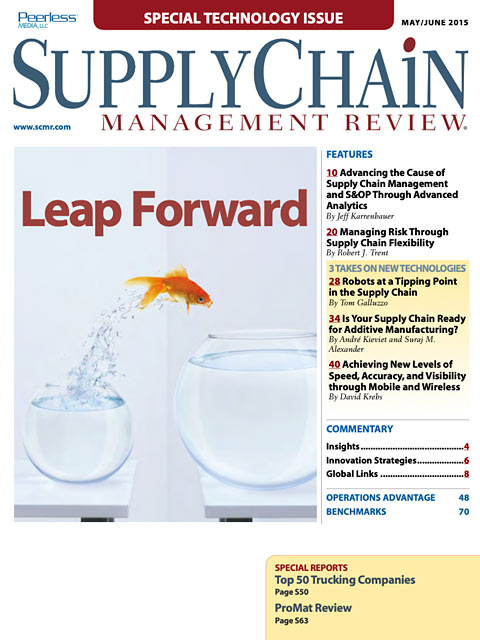Sorry, but your login has failed. Please recheck your login information and resubmit. If your subscription has expired, renew here.
May-June 2015
As supply chain managers we are challenged year in and year out to figure out new, innovative ways to improve our operations. We have to translate educated guesses about what’s next into new investments in our processes. Such may be the case with robotics, 3D printing and additive manufacturing, and investments in new mobile technologies. However, successful planning, including planning for risk, resiliency, and flexibility, can help prepare you for whatever is next. Browse this issue archive.Need Help? Contact customer service 847-559-7581 More options
It has become a classic example of the effects of supply chain disruption: the time when fire destroyed the premises of a supplier that provided Nokia and Eriksson with critical components for mobile phones.
The two companies had entirely different responses to the event, resulting in a dramatic industry shift. Nokia was able to secure components quickly from other sources. By contrast, Eriksson struggled to respond. The disruption not only cost the company several hundred million dollars in lost sales; it essentially ended its position as a player in the growing wireless phone business. Poor business continuity planning by Eriksson, combined with a lack of supply chain flexibility, turned a hazard risk into a strategic risk.
As the search continues for new and improved ways to manage supply chain risk, senior managers will put more and more of a premium on operations that are as flexible as possible. The concept of flexibility is receiving increased attention in the popular press as well as from supply chain professionals. A global supply chain survey conducted by PwC and reported in Industry Week concluded that almost 65 percent of respondents plan to implement greater flexibility to better respond to supply chain challenges, making flexibility a top supply chain priority.
 |
This complete article is available to subscribers
only. Click on Log In Now at the top of this article for full access. Or, Start your PLUS+ subscription for instant access. |
SC
MR
Sorry, but your login has failed. Please recheck your login information and resubmit. If your subscription has expired, renew here.
May-June 2015
As supply chain managers we are challenged year in and year out to figure out new, innovative ways to improve our operations. We have to translate educated guesses about what’s next into new investments in our… Browse this issue archive. Access your online digital edition. Download a PDF file of the May-June 2015 issue.
 |
Download Article PDF |
It has become a classic example of the effects of supply chain disruption: the time when fire destroyed the premises of a supplier that provided Nokia and Eriksson with critical components for mobile phones.
The two companies had entirely different responses to the event, resulting in a dramatic industry shift. Nokia was able to secure components quickly from other sources. By contrast, Eriksson struggled to respond. The disruption not only cost the company several hundred million dollars in lost sales; it essentially ended its position as a player in the growing wireless phone business. Poor business continuity planning by Eriksson, combined with a lack of supply chain flexibility, turned a hazard risk into a strategic risk.
As the search continues for new and improved ways to manage supply chain risk, senior managers will put more and more of a premium on operations that are as flexible as possible. The concept of flexibility is receiving increased attention in the popular press as well as from supply chain professionals. A global supply chain survey conducted by PwC and reported in Industry Week concluded that almost 65 percent of respondents plan to implement greater flexibility to better respond to supply chain challenges, making flexibility a top supply chain priority.
 |
SUBSCRIBERS: Click here to download PDF of the full article. |
SC
MR

Latest Supply Chain News
- How S&OP provides the answer to in-demand products
- AI, virtual reality is bringing experiential learning into the modern age
- Humanoid robots’ place in an intralogistics smart robot strategy
- Tips for CIOs to overcome technology talent acquisition troubles
- There is still work to do to achieve supply chain stability
- More News
Latest Podcast

 Explore
Explore
Topics
Latest Supply Chain News
- How S&OP provides the answer to in-demand products
- AI, virtual reality is bringing experiential learning into the modern age
- Humanoid robots’ place in an intralogistics smart robot strategy
- Tips for CIOs to overcome technology talent acquisition troubles
- There is still work to do to achieve supply chain stability
- Blooming success: The vital role of S&OE in nurturing global supply chains
- More latest news
Latest Resources

Subscribe

Supply Chain Management Review delivers the best industry content.

Editors’ Picks





